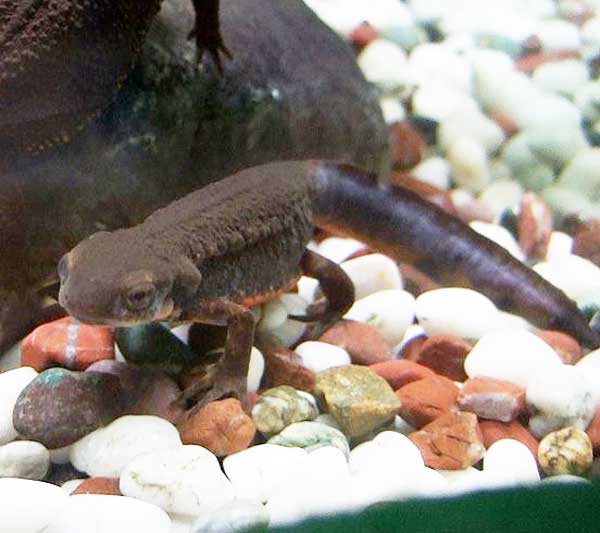Cynops pyrrhogaster (*) Cladus: Eukaryota Name Cynops pyrrhogaster (Boie, 1826) Type locality: "Japan". Lectotype: ZMA 7286. Synonyms * Molge pyrrhogaster Boie, 1826
* Boie, 1826, Isis von Oken, 18: 215. * 2007 IUCN Red List of Threatened Species IUCN link: Cynops pyrrhogaster (Least Concern) Downloaded on 7 August 2008.
The Japanese Fire Belly Newt (Cynops pyrrhogaster) is a common Asian newt. It is commonly confused with the Chinese Fire Belly Newt (Cynops orientalis) due to similarities in coloring and size, and most newts sold as Japanese Fire Bellys are likely to be the more commonly collected Chinese Fire Belly instead. Description This newt is usually 3.5 - 5.5 inches [1] long and can be distinguished from its Chinese relative by its larger size, rough, pebbly skin and distinct parotoid glands. They are typically brown to black above, often with red specks or spots, and orange to crimson below, usually with a blotched darker pattern.[1] Males can be distinguished from females by their swollen cloacas, and male newts of this species will often become a blue iridescent sheen and smoother skin during the breeding season. In the wild this species of newt lives on the islands of Honshū, Shikoku, and Kyūshū. It lives in clear, cool bodies of water, usually ponds, ditches, pools, or lakes.[1] There are reportedly six subspecies or races found through the Japanese islands. These six races are Atsumi, Hiroshima, Kanto, Sasayama, and Touhoku.[1] Each race originating from the region of Japan they are named after. Most people say that they are poisionus but it is not true. In captivity Japanese Fire Belly Newt. Japanese Fire Belly newts prefer aquarium with a small land area to crawl out on and heavy stands of aquatic plants. They do not need any special lighting, but incandescent light can be used. You will need at least a 2.5 gallon terrarium. The best land-water ratio is 1/3 land and 2/3 water, with at least 4 inches in depth. It is best to have a hiding spot/cave to avoid stressing out the newts. The ideal substrates for a newt terrarium are either any moss besides peat moss, sand, or fairly large gravel to avoid ingestion. The water should be about 60-74°F, though these newts can tolerate much higher temperatures than other species. Like other newts, they can be fed commercial pellets or freeze-dried food, but if they refuse these, they should be given live food such as bloodworms, earthworms, mosquito larva, ghost shrimp, nightcrawlers, or pinhead crickets. In order to feed a newt earthworms of any sort, you must chop them into bite sized pieces. Worms can live as long as 8 years if kept at good health. At least one inch of the clitellum (head) is left. You can either feed by hand, or with tweezers of forceps of some kind. Uneaten crickets must be removed, as they will bite a sleeping newt.
References 1. ^ a b c d Caudata Culture Species Entry - Cynops pyrrhogaster - Japanese firebelly * Kaneko & Matsui (2004). Cynops pyrrhogaster. 2006. IUCN Red List of Threatened Species. IUCN 2006. www.iucnredlist.org. Retrieved on 12 May 2006. Database entry includes a range map and justification for why this species is of least concern Source: Wikipedia, Wikispecies: All text is available under the terms of the GNU Free Documentation License |
|

